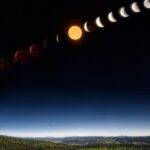A Spectacular Celestial Display
Stargazers worldwide are in for a treat as they anticipate another extraordinary cosmic phenomenon following the recent total solar eclipse. Astronomers reveal that the stars of T Coronae Borealis (T CrB), a binary system located approximately 3,000 light years away, are poised to dazzle during an exceptionally rare event later in 2024.
The Nova Explosion Spectacle
The anticipated spectacle is a rare nova explosion, expected to illuminate the skies for an entire week. According to NASA, the precise timing of this event remains uncertain, with astronomers awaiting further observations to determine its occurrence window.
Once-in-a-Lifetime Occurrence
Nova explosions, such as the imminent event involving T CrB, are exceedingly uncommon, typically occurring once a century. For many, witnessing this celestial display will be a once-in-a-lifetime experience.
The Science Behind the Phenomenon
These awe-inspiring events occur when a collapsed white dwarf star and a red giant star approach each other closely. This proximity causes a dramatic rise in the red giant’s surface temperature, soaring from typical levels of 4,000 to 5,800 degrees Fahrenheit to an astounding 360,000 degrees Fahrenheit.
The Explosive Outcome
The heightened temperatures prompt the red giant to shed its outer layers onto the white dwarf, resulting in a colossal explosion akin to a nuclear blast. This release of energy surpasses the Sun’s annual output by a staggering 100,000 times.
The Aftermath and Unique Characteristics
Following the explosion, the star enters a cooling phase before resuming its cycle. Unlike a supernova, this event does not destroy the star. T CrB and its stellar companions have experienced eruptions throughout history, with notable occurrences documented in 1946 and 1866, possibly extending back centuries.
Viewing Recommendations
To observe this celestial spectacle, enthusiasts are advised to direct their gaze toward the Corona Borealis constellation, also known as the Northern Crown, situated near Bootes and Hercules. While the event’s peak brightness will be visible to the naked eye for several days, enhanced viewing with binoculars or a telescope extends visibility to over a week.
Anticipating Future Events
Given the last recorded nova explosion in 1946, astronomers speculate a recurrence approximately every 79 years, suggesting the next event may unfold in 2103.
Conclusion: Embrace the Celestial Splendor
As anticipation builds for the rare nova explosion of T Coronae Borealis, stargazers eagerly await the breathtaking display of cosmic forces. Don’t miss this once-in-a-lifetime opportunity to witness the beauty and grandeur of the universe. Download The Local News App to stay updated on celestial events and more.







Leave a Reply